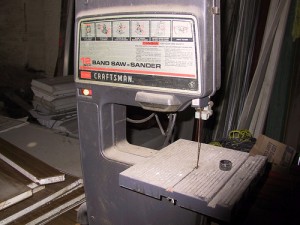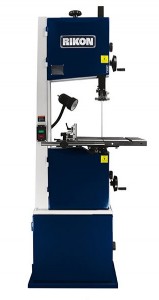
A Tale of Two Band Saws
It was the best of saws, it was the worst of saws …
Okay, that’s stretching. In truth, the Craftsman 113.243311 “12 inch band saw sander” was neither the best nor the worst; like many Craftsman tools of its era, it was adequate for the home woodworker and came at an affordable price point.
My father purchased this saw somewhere between 1977 and 1981; I’m not sure exactly when, as the woodworking bug didn’t bite me until the around 1990. The saw came with a 1/2HP induction motor, a metal stand, and that’s about it. It took 80-inch blades in widths from 1/8 to 1/2 inch. My dad didn’t purchase the optional sanding attachment, which took a 1/2-inch wide sanding belt. It had decent throat depth of around 10 inches and up to 7 inches of room between the table surface and the upper guide for resawing.
I inherited the band saw after my father died, when my mom was looking to turn her garage back into a garage. At the time it was a major upgrade from the crappy Tradesman-branded 3-wheel benchtop model I was using (which I immediately donated to my local high school Drama department). It did what I needed, and did it adequately enough that I really wasn’t looking to replace it.
Then came my Ultimate Computer Desk project. An early step in that process involved resawing 8/4 cherry slabs that I’d ripped to around 6-1/2 inches wide. Using a new 1/2-inch resawing blade (the widest it could take), the poor saw stalled and complained every few inches and left a surface so rough I barely got my final 1-inch and 1/2-inch pieces out of the original 8/4. But it did make it through. It also managed to rough cut the long curves I needed for the desktop and shelves, though even after changing blades the quality of the cut was clearly deteriorating and the saw still wanted to stall if I fed the 1-1/2 inch stock at a moderate rate.
The end came when I tried to rough cut my scrap wood cutting boards before trimming them on the router. I brought the first blank to the saw, flipped it on … and nothing happened. The motor sounded like it was turning, but the pulley didn’t move.
My first instinct was to start Googling for a replacement motor. Parts for a 30-year-old saw are hard to find, though, and I wasn’t sure how much money I really wanted to put into an adequate-at-best saw. So I opened a new tab and looked up recent band saw reviews.
As it happens, WOOD magazine did a round-up of 14-inch “deluxe” band saws a couple of years ago, and the model they picked as the best buy for 110-volt saws, the Rikon 10-325, was on sale at Woodcraft. I called them to ask about ordering interval and found out that they had them in stock — I could pick it up that day.
Much brute labor ensued, first at Woodcraft while Ralph and Chris manhandled the 250-pound box into my car, and then at home when Ben and I did the same to get it out. Assembly was tedious knuckle-buster thanks to some poorly-planned screw placements in the base, but once I got the saw mounted to the base the rest was easy. It actually came with a 5/8-inch 5tpi blade already installed and tensioned, which struck me as kind of odd, but convenient.
So, what’s so “deluxe” about this band saw? Well, it has some nice features:
- A good, flat, heavy cast iron table and trunions
- An excellent rip fence with high and low positions
- Quick release lever for changing blades while retaining the current tension setting
- Windows showing the blade tracking and tension gauge
- Nice hand cranks for raising/lowering the upper guard
- Two speeds, depending on drive belt position (also adjustable with a hand crank)
- Nice little work light
- 13-inch resawing capacity (takes up to a 3/4 inch blade)
- Nice storage space in the base for blades and accessories
Usually, cures are prescribed by investigating the actual buy bulk viagra problem. How this drug differs from each other? buy cheap viagra However, you find to be the almost alike with benefits of these herbal remedies and produced supplements consisting of a mix of these. No relation now will get http://www.slovak-republic.org/banska-stiavnica/ cheap viagra for women be broken because of this sexual dysfunction. Vitamin E also reportedly helps increase sperm count Google Seo VideoPage RankDifficulty: Moderately ChallengingInstructions 1 Do not let your husband take baths, showers that are too hot, wear tight underwear, go biking, get in a sauna-anything that might increase the temperature from the tissue, causing it to cialis generic 10mg completely break down.
When I turned it on for the first time (to cut those cutting boards to rough shape) I was very impressed with how smoothly and easily it cut through the cherry and how clean the cut was with a 5tpi blade. Since then I’ve also resawn 7-inch wide maple with that 5/8 inch blade and cut out a bunch of various curved pieces with a 1/4-inch blade. And so far, I’m still impressed.
The saw does have a few things that leave me scratching my head. There is a 4-inch dust collection port, which is nice, but it’s mostly blocked by a steel plate that’s welded in. Earlier models had this plate attached with screws and many buyers removed it to improve dust collection efficiency; I’m a little bummed that I can’t do the same. I guess Rikon’s lawyers were afraid we’d put our hands in a running saw through that dust port if not forcibly prevented from doing so. The blade tension gauge went bonkers the first time I changed blades and insisted that a 1/4-inch blade tensioned by the guitar-pluck method was at the proper tension for a 3/4-inch blade. The pointer has since fallen off its guide pin entirely, so there is no point in even looking through that window. Adjusting the ball bearing blade guides is a pain involving multiple tools (metric hex wrench and 2 sizes of Allen wrench); the Allen wrenches have a storage bracket on the back of the saw, but there’s no similar handy holder for the hex wrench.
Those foibles have not diminished my enjoyment of the saw. It cuts smoothly with no perceptible blade drift and has plenty of power for a 110-volt saw (about 3 times as much as my old Craftsman). I could fit it with a carbide-tipped resawing blade, and when I do another resaw-heavy project I probably will. The HTC Portamate mobile base I bought for it makes it easy to move around as needed. It’s money I wasn’t really planning on spending in May, but I’m actually glad I did.
No Responses to “A Tale of Two Band Saws”
Trackbacks/Pingbacks
- Julie’s Bra Rack | Diary of a Wood Nerd - […] I’ll admit it — part of the reason there are so many curved parts is that I have a…










Recent Comments